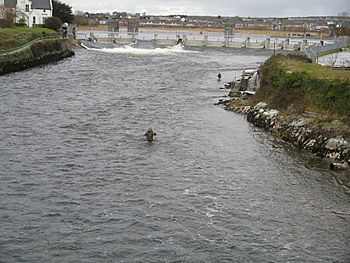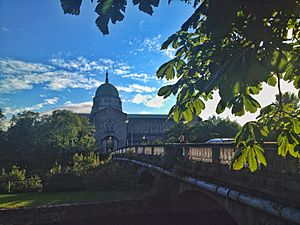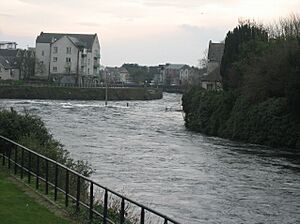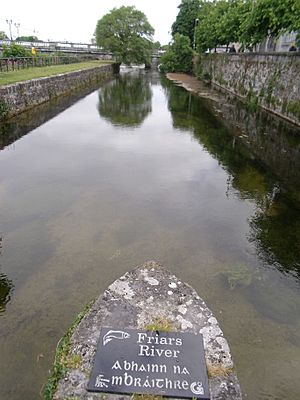River Corrib facts for kids
Quick facts for kids River Corrib |
|
|---|---|

Looking north from the Salmon Weir Bridge in Galway
|
|
| Native name | Abhainn na Gaillimhe |
| Country | Ireland |
| Physical characteristics | |
| Main source | Lough Corrib |
| River mouth | Galway Bay and Atlantic Ocean at the Claddagh 53°16′02″N 9°02′46″W / 53.26717°N 9.04599°W |
| Length | 6 kilometres (3.7 mi) |
| Basin features | |
| Basin size | 3,101 km2 (1,197 sq mi) |
The River Corrib (in Irish: Abhainn na Gaillimhe) is a short but powerful river in the west of Ireland. It flows from Lough Corrib through the city of Galway and into Galway Bay. This river is one of Europe's shortest, measuring only six kilometres from the lake to the Atlantic Ocean.
Even though it's short, the River Corrib is very strong. It has a high flow rate of about 104.8 cubic metres of water per second. This makes it Ireland's second-largest river by water flow, right after the River Shannon. The river is also quite deep, reaching up to 94 feet in some places. It collects water from a large area of 3,138 square kilometres.
The River Corrib is a popular spot for fun activities. Many local kayakers enjoy its waters. Several rowing clubs and pleasure boats also use the river regularly.
Contents
What's in a Name? The Story of the River Corrib
The name of the River Corrib comes from the Irish name Gaillimh, which means "Galway river". Sometimes in Irish, it's simply called An Ghaillimh, meaning "the Galway".
How the River Got Its Name
There's a legend about how the river got its name. It's said to be named after Gaillimh inion Breasail. She was the daughter of a Fir Bolg chieftain who sadly drowned in the river. The word Gaillimh is thought to mean "stony," suggesting it was a "stony river."
Some people used to think that the city of Galway got its name from the Irish word Gallaibh, meaning "foreigners." But this isn't true. The name Gaillimh was first given to the river, and then later to the town that grew beside it. In fact, the very first settlement in Galway was called Dún Bhun na Gaillimhe. This means "the fort at the end of the Galway (river)."
How the River Helped Galway Grow
The river played a huge role in the growth of Galway. It helped the town develop electrical power even before London had it! This shows how important the river's strong flow was.
At one time, there were more than twenty water wheels working along the river. These wheels were powered by the river's flow and by a special channel called the Eglinton Canal. This canal was built in the mid-1800s as part of a big project to improve navigation and drainage for Lough Carra, Lough Corrib, and Lough Mask.
The Eglinton Canal is about three-quarters of a mile long. It had a lock to connect to the sea, a large basin, and another lock further up. Even though the old swivelling bridges have been replaced, the canal still holds water.
The Name of Lough Corrib
Lough Corrib is the English version of Loch Coirib. This name itself comes from an older name, Loch nOrbsean. According to old stories, this lake was named after the Irish god of the sea. Both the lake and the river are known for good fishing.
Ancient Names for the River
An ancient book called Geography, written by Ptolemy in the 2nd century AD, described a river called Αυσοβα (Ausoba). This ancient name likely referred to the River Corrib.
Exploring the Upper and Lower Corrib River Sections
The River Corrib is divided into two main parts: the Upper Corrib and the Lower Corrib.
The Upper Corrib: From Lake to Weir
The Upper Corrib is the part of the river that flows from the southern end of Lough Corrib down to the Salmon Weir. The Salmon Weir is a set of gates that help control the river's flow. It was originally made of stone and wood. Today, most of the old gates have been replaced by fourteen strong steel gates. These gates are only opened when there's a lot of water, like during floods.
The main channel that leaves Lough Corrib is called Friars' Cut or Friars' River (in Irish: Abhainn na mBráithre). This channel is actually a very old man-made canal! Back in 1178, the friars from Claregalway Friary wanted an easier way to get to the river. So, they asked for permission to dig an artificial cut. Over time, this cut became the main path of the river and was made even wider.
The Lower Corrib: Through Galway City
The Lower Corrib is the section of the river that flows from the Salmon Weir, right through Galway city, and out into Galway Bay.
Bridges Crossing the Lower Corrib

There are four bridges that cross the Lower Corrib in Galway:
- The Salmon Weir Bridge
- The William O'Brien Bridge
- The Wolfe Tone Bridge
- The Quincentenary Bridge
Streams Joining the Lower Corrib
The only small stream that flows into the Lower Corrib is called Sruthán na gCaisleáin, which means "Castle Stream." This stream flows through the area of Newcastle and the grounds of NUI Galway before joining the Lower Corrib.
The official magazine of NUI Galway is even named Cois Coiribe, which means "Beside the Corrib," showing how important the river is to the area.
Images for kids
-
Kayaking the large standing wave at O'Briens Bridge
See also
 In Spanish: Río Corrib para niños
In Spanish: Río Corrib para niños




